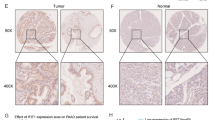Abstract
The Wnt secretion protein Wntless (Wls)/GPR177 has been reported to be involved in the development of several human cancers. However, the biological significance of Wls in breast cancer progression has not been clarified. In this study, we show for the first time that Wls is an important molecule related to breast cancer. We find that Wls expression is markedly increased in clinical breast tumors compared with adjacent noncancerous tissues. Downregulation of Wls by short-hairpin RNA severely suppressed the proliferation of breast cancer cells. Wls is a core Wnt signaling component, and we show that knockdown of Wls is sufficient to inhibit Wnt secretion and its downstream signaling. Taken together, these results indicate that Wls contributes to the proliferation of breast cancer cells by regulating Wnt signaling. Therefore, Wls could be a novel therapeutic target for inhibiting cell growth in breast cancer.



Similar content being viewed by others
References
Glass AG, Lacey JV Jr, Carreon JD, Hoover RN. Breast cancer incidence, 1980–2006: combined roles of menopausal hormone therapy, screening mammography, and estrogen receptor status. J Natl Cancer Inst. 2007;99:1152–61.
Ferlay J, Steliarova-Foucher E, Lortet-Tieulent J, et al. Cancer incidence and mortality patterns in Europe: estimates for 40 countries in 2012. Eur J Cancer. 2013;49:1374–403.
Zeng Z, Lin H, Zhao X, et al. Overexpression of GOLPH3 promotes proliferation and tumorigenicity in breast cancer via suppression of the FOXO1 transcription factor. Clin Cancer Res. 2012;18:4059–69.
Banziger C, Soldini D, Schutt C, Zipperlen P, Hausmann G, Basler K. Wntless, a conserved membrane protein dedicated to the secretion of Wnt proteins from signaling cells. Cell. 2006;125:509–22.
Yu J, Chia J, Canning CA, Jones CM, Bard FA, Virshup DM. WLS retrograde transport to the endoplasmic reticulum during Wnt secretion. Dev Cell. 2014;29:277–91.
Eaton S. Retromer retrieves Wntless. Dev Cell. 2008;14:4–6.
Bartscherer K, Pelte N, Ingelfinger D, Boutros M. Secretion of Wnt ligands requires Evi, a conserved transmembrane protein. Cell. 2006;125:523–33.
Hausmann G, Banziger C, Basler K. Helping wingless take flight: how WNT proteins are secreted. Nat Rev Mol Cell Biol. 2007;8:331–6.
Fu J, Jiang M, Mirando AJ, Yu HM, Hsu W. Reciprocal regulation of Wnt and Gpr177/mouse Wntless is required for embryonic axis formation. Proc Natl Acad Sci USA. 2009;106:18598–603.
Maruyama EO, Yu HM, Jiang M, Fu J, Hsu W. Gpr177 deficiency impairs mammary development and prohibits Wnt-induced tumorigenesis. PLoS One. 2013;8:e56644.
Augustin I, Goidts V, Bongers A, et al. The Wnt secretion protein Evi/Gpr177 promotes glioma tumourigenesis. EMBO Mol Med. 2012;4:38–51.
Voloshanenko O, Erdmann G, Dubash TD, et al. Wnt secretion is required to maintain high levels of Wnt activity in colon cancer cells. Nat Commun. 2013;4:2610.
Stewart J, James J, McCluggage GW, et al. Analysis of Wntless (WLS) expression in gastric, ovarian, and breast cancers reveals a strong association with HER2 overexpression. Mod Pathol. 2015;28:428–36.
Chiou SS, Wang LT, Huang SB, et al. Wntless (GPR177) expression correlates with poor prognosis in B-cell precursor acute lymphoblastic leukemia via Wnt signaling. Carcinogenesis. 2014;35:2357–64.
Yang PT, Anastas JN, Toroni RA, et al. WLS inhibits melanoma cell proliferation through the ss-catenin signalling pathway and induces spontaneous metastasis. EMBO Mol Med. 2012;4:1294–307.
Nusse R. Wnt signaling and stem cell control. Cell Res. 2008;18:523–7.
Kaur N, Chettiar S, Rathod S, et al. Wnt3a mediated activation of Wnt/beta-catenin signaling promotes tumor progression in glioblastoma. Mol Cell Neurosci. 2013;54:44–57.
Clevers H, Loh KM, Nusse R. Stem cell signaling. An integral program for tissue renewal and regeneration: Wnt signaling and stem cell control. Science. 2014;346:1248012.
Reya T, Clevers H. Wnt signalling in stem cells and cancer. Nature. 2005;434:843–50.
Ponder BA. Cancer genetics. Nature. 2001;411:336–41.
Bartek J. DNA damage response, genetic instability and cancer: from mechanistic insights to personalized treatment. Mol Oncol. 2011;5:303–7.
Klaus A, Birchmeier W. Wnt signalling and its impact on development and cancer. Nat Rev Cancer. 2008;8:387–98.
Lindvall C, Bu W, Williams BO, Li Y. Wnt signaling, stem cells, and the cellular origin of breast cancer. Stem Cell Rev. 2007;3:157–68.
Polakis P. The many ways of Wnt in cancer. Curr Opin Genet Dev. 2007;17:45–51.
Behrens J, Lustig B. The Wnt connection to tumorigenesis. Int J Develop Biol. 2004;48:477–87.
Barker N, Clevers H. Mining the Wnt pathway for cancer therapeutics. Nat Rev Drug Discovery. 2006;5:997–1014.
Banziger C, Soldini D, Schutt C, Zipperlen P, Hausmann G, Basler K. Wntless, a conserved membrane protein dedicated to the secretion of Wnt proteins from signaling cells. Cell. 2006;125:509–22.
Acknowledgments
This work was supported by the National Natural Science Foundation of China (81101493).
Conflict of interest
The authors state that they have no conflict of interest.
Ethical standard
These specimens were collected from the patients registered at the above-mentioned hospital, and written informed consent was obtained from the patients. This study was approved by the ethics committee of the hospital.
Author information
Authors and Affiliations
Corresponding author
Rights and permissions
About this article
Cite this article
Lu, D., Li, Y., Liu, QR. et al. Wls promotes the proliferation of breast cancer cells via Wnt signaling. Med Oncol 32, 140 (2015). https://doi.org/10.1007/s12032-015-0585-z
Received:
Accepted:
Published:
DOI: https://doi.org/10.1007/s12032-015-0585-z




